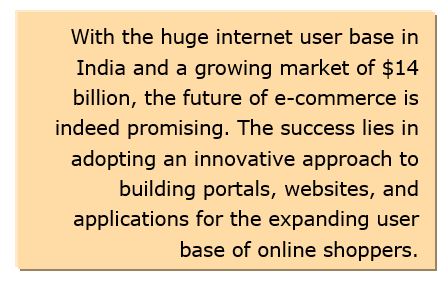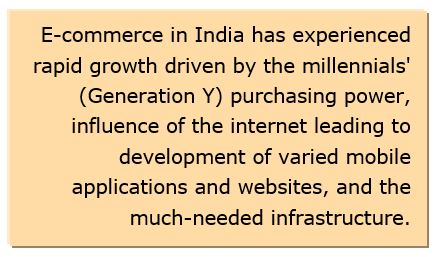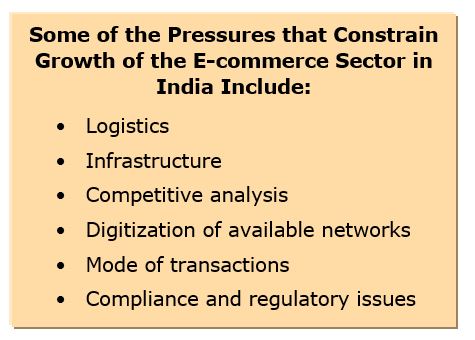

E-commerce is witnessing a global resurgence, and E-commerce in India is booming based, in part, on increased access to the 
India's huge and still-expanding base of internet users includes increasing penetration into the rural market. This promises a bright future for e-commerce. Whether purchasing e-tickets from Indian Railways or fast-moving consumer goods (FMCG) and other lifestyle products, consumers have started getting accustomed to the online platform, which enables easier transactions and delivery at the preferred location.
The gradual change in the buying patterns of Indian consumers resulted in the mushrooming of start-ups in the e-commerce market. By offering options for payment on delivery and return policies, plus attractive deals and discounts, online retailers have retained and grown their base of online consumers. According to reports, India's e-commerce industry has some of the key players in the $100-million club. These include established player, Amazon, plus Flipkart, Snapdeal, Ola Cabs, Paytm, InMobi, Zomato, Quikr and many other start-ups that are propelling growth of this sector.
According to NASSCOM, India's $14 billion Indian e-commerce market which started as a niche industry a few years ago has been gaining momentum and shows more than 25 percent growth. Online travel is the largest segment with about 70 percent market share, a figure that's likely to escalate. E-commerce is expanding its reach to the general masses on the back of social media, which not only provides a mechanism for advertising but also for receiving feedback, building brand image, and promoting new launches. Online retailers also use social media to track the first-time and repeat buyers of a product. Social media has become a platform to study consumer lifestyles and spending patterns.
E-commerce, driven by digitization and internet penetration in the rural market, is creating huge opportunities for consumers. Competitive prices, deals, and efficient delivery coupled with the convenience of avoiding long queues have completely altered the buying experience. According to NASSCOM, India's e-commerce market is forecasted to cross a whopping $200 billion by 2030 due to increased analytics, transactions, and internet penetration.
E-commerce is revitalizing consumer demand and catalyzing growth in India's retail industry. The focus has shifted a pricing model to a more value-added model. Among the fastest growing domestic segments, the most popular categories are tours & hotel reservations; airline and railway tickets; and lifestyle and entertainment related products. The innovative business models of the "e-tail" market attract more repeat customers. Although there is a strong build-up of the e-commerce industry, a vast portion of the population is not yet aware of the benefits. This represents a huge potential untapped market for e-tailers.
Among many other components, product availability is one of the primary drivers that cannot be overlooked. In smaller cities where the consumers may be confined to limited brands and availabilities, online shopping with the flexibility of delivery options and possibility of getting what they are looking for has a wider scope.
A robust supply chain and a well-established reverse logistics network in India will enhance the success of e-commerce companies. E-commerce companies and similar enterprises seek a particular logistics requirement that may not be executed by traditional logistics suppliers. The courier companies that generally deliver documents are not experienced in delivering commercial goods. Thus, the e-commerce companies are establishing their own delivery network. One such example is Flipkart's logistics, which is 
E-commerce in India has experienced rapid growth driven by the millennials' (Generation Y) purchasing power, influence of the internet leading to development of varied mobile applications and websites, and the much-needed infrastructure. Mobile penetration accounts for a vast market in India, making it more convenient for consumers to shop for a wide variety of retail products. Other factors enabling growth of the industry include:
While this sector shows immense promise, certain challenges need to be addressed. Some of the pressures that constrain growth include:

Infrastructure: E-commerce players also need to address the infrastructure needed to overcome payment problems, build offline presence, implement more push-marketing, manage price-sensitive customers, and compete on a global turf. The payment gateway infrastructure is still at the nascent stage. The merchants have yet to make amendments on the mobile front. As an example, one of the leading e-commerce players in India could not handle the requests of its customers on Big Billion Days' sale program due to unorganized delivery framework.
Competitive Analysis: E-commerce companies have to focus on issues pertaining to rapid additions of customer segments and product portfolios. Information should be collected related to market intelligence on growth, size and share, and managing multiple customer engagement platforms in order to expand into new geographies, brands & products; while simultaneously controlling a very competitive pricing environment.
Digitization of Available Networks: At present, social media plays a significant role in the life of an internet surfer/customer. Thus companies have to provide a rich experience by managing erratic demands and inconsistent brand experience across platforms, in addition to handling time-to-market efforts for new launches, applications, and websites.
Mode of Transactions: Concerns about security, privacy, and tracking fraudulent purchases are some external forces that impact a business. Other factors like cross-border tax, back-end service tax, and regulatory issues can have serious implications for e-commerce companies.
Other issues e-commerce businesses must deal with include inability of the organizational structure to keep pace with the rapid changes, cybersecurity for preventing fraudulent transactions and insider threats, tax restructuring, and legal compliance.
The e-commerce sector in India is maturing and there is ample scope for growth. However, growth comes incumbent with challenges on multiple fronts: operational, management, regulatory & compliance, along with the fluctuating consumer demands. The expansion of the internet user base and people buying online suggests that the e-commerce companies should focus on customer experience and technological advancements to accelerate growth. Apart from this, to provide a gamut of offerings and increase reach, companies should ensure faster speed for their websites and devise easier-to-use mobile applications to enhance user experience.
Companies should also develop omni-channel business strategies to retain customer loyalty. Addressing the right market with continuous innovation for a better operational framework, same day delivery options like the Kirana shops ("mom and pop" stores); and convergence of online-offline shopping are some of the innovations that the e-commerce companies are executing to meet the growing competition.
Large e-commerce companies are on an acquisition spree to garner market share and enhance their capabilities in a cash-intensive sector. These players are trying to wield more clout, enhance variety, and increase their respective customer bases through these strategic acquisitions.
E-commerce is the convergence of convenient shopping, competitive pricing, discounts, etc. The changing market dynamics pave the way to a new model that includes hyper-local space with innovative transactional platforms, payment solutions, and a virtual brick-and-mortar retail experience. Old foundations based on price and quality will be replaced by a more enjoyable and richer user experience through guidance on selecting the right product, personalization, etc. The growth of core online retailers in India is driving brick-and-mortar stores to revamp their operations across regions.
Please Contact Us if you would like to speak with the author.
Keywords: Digitization, Millennials, Cybersecurity, E-commerce, ARC Advisory Group.

